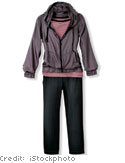Green Is the New Chic

No more hemp sacks! Eco-clothing used to be like high-fiber cereal—crunchy, healthy and a little boring. Now it's possible to do good and look good. Real good.
A cleaner planet can start in our very own closets now that ecologically correct clothing has surpassed its homespun image. There's a real push toward capital- F fashion, with hip stores like Barneys New York commissioning earth-friendly collections from high-end designers. And as huge retailers like Wal-Mart (the largest private consumer of electricity in the United States) and JC Penney kick off green initiatives, there's reason to hope that environmentally responsible products and practices will become a mass movement. "What we're seeing is a cultural shift, not just a trend," says green-lifestyle entrepreneur Danny Seo, 30, who is partnering with Penney on its new Simply Green line that includes everything from towels to socks. Fashion is one of the last areas to transition from fad to something more mainstream and concrete. "But once people start asking questions about fabrics or dyes or labor practices, it sort of snowballs," Seo says. "That's how change happens."See the collections: 4 designers gone green
Eco-pioneers who explore innovative materials and groundbreaking dyes are changing fashion from the ground up. "I am interested in not only the final result but the craft itself," says John Patrick, founder and designer of the Organic collection. "It's a very long chain from seed to shirt." A key factor in environmental style is raw materials—organically produced traditional crops; versatile fibers like bamboo, hemp, and soybean; and fabrics cooked up out of everything from recycled plastic to seaweed. Weaving, quilting, and other time-honored handicrafts with links to indigenous cultures put a personal stamp on garments. And although organic style is usually associated with a natural, beige-to-brown palette, the development of plant-based, nontoxic dyes has ushered in a Technicolor new age...another reason that today's "green" clothing looks less like whole grain cereal and more like fashion.
Serious runway fashion is embracing a greener viewpoint—or maybe it's simply that the environmental movement has started to look forward rather than back to a lost paradise. Certainly Barneys New York has put its considerable clout to work on behalf of the Earth with a spring campaign that features a number of exclusive green collections. Young, hot, thoughtful designers such as Phillip Lim and Behnaz Sarafpour represent a new generation that's grown up alongside the push for a cleaner planet (Lim, who's 34, wasn't yet born when Earth Day was invented). Modern is a word that recurs in their self-descriptions, making it clear that embracing socially responsible production methods doesn't mean sacrificing fabulous style. Sarafpour is particularly engaged by the irregularities and variations that come with using natural materials and dyes (which are less consistent than conventionally manufactured materials). "There is beauty in that organic element of surprise," she says.
Get inspired: Styles so chic, you won't believe they're eco.
Eco-intelligent fashion isn't just clothes minded; it's about activism—whether that means small shifts in our everyday habits or ambitious projects to establish industry in developing countries rather than simply exploiting their raw materials. "Trade can and should supersede aid," says Ali Hewson, whose label, Edun—founded with her husband, U2's Bono, and designer Rogan Gregory—has a growing reputation for top quality, offhand cool, and eco-ethical practices: Its aim, she says, is to "lift communities out of poverty." (Gregory, who has an eco-friendly line with Barneys New York, also has a green line for Target debuting in May.) Closer to home, environmental authority Danny Seo urges us to avoid throwaway fashion, however enticingly cheap and chic; save energy by buying compact fluorescent lightbulbs and unplugging cell-phone chargers when not in use (they still eat electricity); and set ink-jet printers to draft mode, which makes cartridges last longer. Every little bit—one person's commitment, one company's policies—really does make an immense difference.



